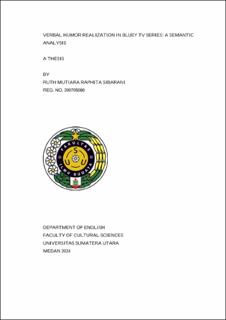Verbal Humor Realization in Bluey Tv Series: A Semantic Analysis

Date
2024Author
Sibarani, Ruth Mutiara Raphita
Advisor(s)
Yusuf, Muhammad
Putri, Dian Marisha
Metadata
Show full item recordAbstract
This research aims to identify and analyze various forms of verbal humor for young children displayed in the animated series Bluey. This research focused on fifteen selected episodes of Bluey: Yoga Ball, The Doctor, The Pool, The Sleep Over, Magic Asparagus, Rug Island, Bus, Double Baby-sitter, Ice Cream, Christmas Swim, Obstacle Course, Born Yesterday, Unicorse, Ragdoll, and Fairytale. This research classifies the verbal humor found based on the classification of verbal humor and analyzes verbal humor using General Theory of Verbal Humor (GTVH). Descriptive qualitative method was applied in this study. This research found 51 examples of verbal humor that fit into 9 of the 12 known classifications, whereas Limerick, Riddle, and Tell-Tale were not found. Pun is the most dominant type of verbal humor in selected episodes of Bluey with a total of 13 appearances (25%) followed by irony (22%), wit (13%), sarcasm (12%), farce (10%), joke (8%), each satire and parody (4%) and anecdote (2%). This research explores in depth the implementation of the Six Knowledge Resources of GTVH-Script Opposition (SO), Logical Mechanism (LM), Situation (SI), Target (TA), Narrative Strategy (NS), and Language (LA) to deconstruct humor linguistically, which turns out to be hierarchically structured. The findings contribute to our understanding of how the verbal humor in Bluey is purposely designed to be easily understood by young audiences, in line with their stage of cognitive development. Furthermore, the examination of knowledge sources showed a correlation between humor, language comprehension, and children's cognitive development.
Collections
- Undergraduate Theses [874]
